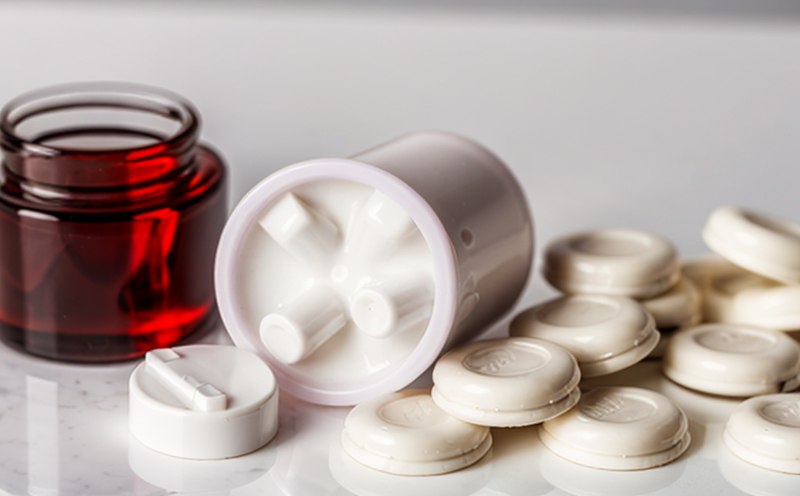USP Photostability Testing of Tablets
The United States Pharmacopeia (USP) Photostability Test is a critical method used to assess the stability of active pharmaceutical ingredients (APIs) and excipients in oral solid dosage forms, such as tablets. This test evaluates how susceptible these materials are to degradation under light exposure, which can significantly affect drug efficacy and safety. The USP Photostability Testing is a key part of ensuring that pharmaceutical products meet the required quality standards before they reach consumers.
The test aims to simulate real-world conditions where tablets might be exposed to light, such as during manufacturing and storage. By exposing samples to controlled light sources with specific wavelengths (typically UV, visible, or both), this method helps predict potential degradation reactions that could occur over time. This information is essential for formulation development, process optimization, and ensuring product quality throughout its shelf life.
During the test, tablets are placed in a photostability chamber designed to mimic various light sources found in different environments, such as natural sunlight or fluorescent lamps used in manufacturing facilities. The exposure duration varies depending on the API's photochemical sensitivity but usually ranges from 48 hours up to several weeks.
After undergoing this treatment, samples are analyzed using analytical techniques like High Performance Liquid Chromatography (HPLC), Infrared Spectroscopy (IR), or Thin Layer Chromatography (TLC). These analyses measure changes in the API's concentration and purity as well as any by-products formed during photochemical reactions. The results provide valuable insights into the stability of the product under specified conditions.
Compliance with USP Photostability Testing requirements ensures that pharmaceutical manufacturers adhere to industry best practices and regulatory guidelines set forth by regulatory authorities worldwide. This helps maintain consistent quality standards across different markets while minimizing risks associated with potential deviations from expected performance.
In summary, USP Photostability Testing plays a crucial role in safeguarding public health by ensuring the integrity and effectiveness of medicines through rigorous scientific evaluation processes that consider environmental factors like light exposure.
Industry Applications
The USP Photostability Test finds application across various sectors within the pharmaceutical industry, including research & development (R&D), manufacturing, quality assurance, and regulatory compliance departments. Here are some key areas where this testing methodology is utilized:
- New Drug Application (NDA): During early stages of drug development, photostability studies help identify potential issues related to light-induced degradation before proceeding further in clinical trials.
- Process Development: Understanding the effects of light exposure aids in optimizing manufacturing processes and selecting appropriate packaging materials that protect products from degrading under typical storage conditions.
- Quality Control: Regular photostability testing ensures ongoing compliance with regulatory requirements and helps monitor changes in product quality over time.
- Regulatory Compliance: Meeting USP standards is mandatory for all pharmaceutical companies seeking approval to market their products domestically or internationally.
| API Sensitivity Levels | Typical Exposure Times (Hours) | Target Products |
|---|---|---|
| Highly Sensitive | 48 - 72 | New drug formulations, unstable APIs |
| Moderately Sensitive | 168 - 336 | Established products undergoing reformulation |
| Lightly Sensitive | 504 - 720 | Products with stable APIs and robust formulations |
The specific exposure time depends on the API's sensitivity level, which is determined based on literature reviews and preliminary experiments. This table provides a general guideline for exposure durations used in photostability testing.
Quality and Reliability Assurance
The USP Photostability Test contributes significantly to maintaining high standards of quality assurance within the pharmaceutical industry. By identifying potential stability issues early on, this test enables manufacturers to make necessary adjustments in formulations or production processes before products reach consumers.
One of the primary goals of photostability testing is to prevent degradation reactions that could lead to reduced efficacy or increased toxicity of medications. Early detection allows for corrective actions such as optimizing packaging designs using light-stable materials, modifying excipient combinations, or adjusting manufacturing procedures to minimize exposure risks.
In addition to preventing quality issues, the test also supports reliability assurance by providing consistent data across different batches and production runs. This consistency is vital in ensuring that every unit produced adheres to strict regulatory requirements set forth by organizations like the USP.
From an operational perspective, photostability testing enhances efficiency by reducing waste from unstable products and improving overall productivity through informed decision-making processes based on scientific evidence rather than guesswork or trial-and-error approaches. This approach fosters a culture of continuous improvement within pharmaceutical companies dedicated to delivering safe, effective medicines.
Customer Impact and Satisfaction
The importance of USP Photostability Testing extends beyond internal processes; it directly impacts customer satisfaction by ensuring that patients receive reliable medications free from degradation concerns. Reliable products instill confidence in customers about the safety and efficacy of their prescribed treatments.
Poorly managed photostability could result in ineffective or potentially harmful drugs reaching consumers, leading to adverse reactions or suboptimal therapeutic outcomes. Such incidents not only harm individual patients but also damage brand reputation and trust among healthcare providers and consumers alike.
On the other hand, adherence to rigorous photostability testing protocols demonstrates a commitment to excellence that enhances customer confidence in pharmaceutical brands. Patients feel safer knowing their medications meet stringent quality standards before being made available on the market.
Moreover, reliable products contribute positively towards healthcare outcomes by ensuring consistent therapeutic benefits regardless of variations in storage conditions or distribution channels. This consistency is particularly important for chronic disease management where adherence to prescribed regimens plays a crucial role in treatment success.





